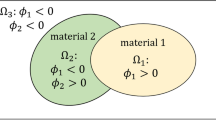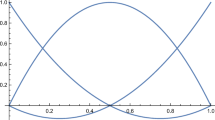Abstract
Combining the vector level set model, the shape sensitivity analysis theory with the gradient projection technique, a level set method for topology optimization with multi-constraints and multi-materials is presented in this paper. The method implicitly describes structural material interfaces by the vector level set and achieves the optimal shape and topology through the continuous evolution of the material interfaces in the structure. In order to increase computational efficiency for a fast convergence, an appropriate nonlinear speed mapping is established in the tangential space of the active constraints. Meanwhile, in order to overcome the numerical instability of general topology optimization problems, the regularization with the mean curvature flow is utilized to maintain the interface smoothness during the optimization process. The numerical examples demonstrate that the approach possesses a good flexibility in handling topological changes and gives an interface representation in a high fidelity, compared with other methods based on explicit boundary variations in the literature.
Similar content being viewed by others
References
Sokolowski JP, Zolesio J. Introduction to Shape Optimization: Shape Sensitivity Analysis. New York: Springer-Verlag, 1992
Bendsoe MP. Optimization of Structural Topology, Shape and Material. Berlin: Springer, 1997
Bendsoe MP. Optimal shape design as a material distribution problem.Structural Optimization, 1989, 1: 193–202
Diaz AR. Bendoe MP. Shape optimization of structures for multiple loading conditions using a homogenization method.Structural Optimization, 1992, 4: 17–22
Allaire G, Kohn RV. Topology optimization and optimal shape design using homogenization.Topology Design of Structures, Kluwer, 1993, volume 227 of NATO ASI Series, Series E: 207–218
Bendsoe MP, Sigmund O. Material interpolations in topology optimization.Archive of Applied Mechanics, 1999, 69: 635–654
Sigmund O. Topology optimization: A tool for the tailoring of structures and materials.Phil Trans: Math Phys Eng Sci, 2000, 358: 211–228
Bendsoe MP. Optimization of structural topology. In: Shape and Material. Berlin: Springer, 1997
Sigmund O. A 99 topology optimization code written in Matlab.Structural and Multidisciplinary Optimization, 2001, 21:120–718
Sigmund O. On the design of compliant mechanisms using topology optimization. Danish Center for Applied Mathematics and Mechanics Report No.535, 1996
Xie YM, Steven GP. Evolutionary Structural Optimization. Springer, 1997
Reynolds D, McConnachie J, Bettess P, et al. Reverse Adaptivity—A new evolutionary tool for structural optimization.Int J Numerical Methods in Engineering, 1999, 45: 529–552
Eschenauer HA, Kobelev HA. Schumacher A. Bubble method for topology and shape optimization of structures.Structural Optimization, 1994, 8: 142–151
Eschenauer HA, Schumacher A. Topology and shape optimization procedures using hole positioning criteria.Topology Optimization in Structural Mechanics, CISM, 1997. 135–196
Sethian JA, Wiegmann A. Structural boundary design via level set and immersed interface methods.Journal of Computational Physics, 2000, 163(2): 489–528
Osher S, Sethian JA. Front propagating with curvature-dependent speed: Algorithms based on Hamilton-Jacobi formulations.Journal of Computational Physics, 1988, 79: 12–49
Shu CW, Osher S. Efficient implementation of essentially non-oscillatory shock capture schemes.Journal of Computational Physics, 1988, 77: 439–471
Osher SJ, Santosa F. Level set methods for optimization problems involving geometry and constrains I. Frequencies of a two-density inhomogeneous drum.Journal of Computational Physics, 2001, 171: 272–288
Gregoire A, Francois JF, Anca-Maria T. A level-set method for shape optimization.C R Acad Sci, Paris Ser, 2002, I, 334: 1125–1130
Wang MY, Wang XM, Guo DM. A level set method for structural topology optimization.Computer Methods in Applied and Engineering, 2003, 192: 227–246
Sethian JA. Level Set Methods and Fast Marching Methods: Evolving Interfaces in Computational Geometry, Fluid Mechanics, Computer Vision, and Materials Science. Cambridge: Cambridge University Press, 1999
Osher S, Fedkiw R. Level set methods: An overview and some recent results.Journal of Computational Physics, 2001, 169: 475–502
Author information
Authors and Affiliations
Additional information
The project supported by the National Natural Science Foundation of China (59805001, 10332010) and Key Science and Technology Research Project of Ministry of Education of China (No.104060)
Rights and permissions
About this article
Cite this article
Yulin, M., Xiaoming, W. A level set method for structural topology optimization with multi-constraints and multi-materials. Acta Mech Sinica 20, 507–518 (2004). https://doi.org/10.1007/BF02484273
Received:
Revised:
Issue Date:
DOI: https://doi.org/10.1007/BF02484273




